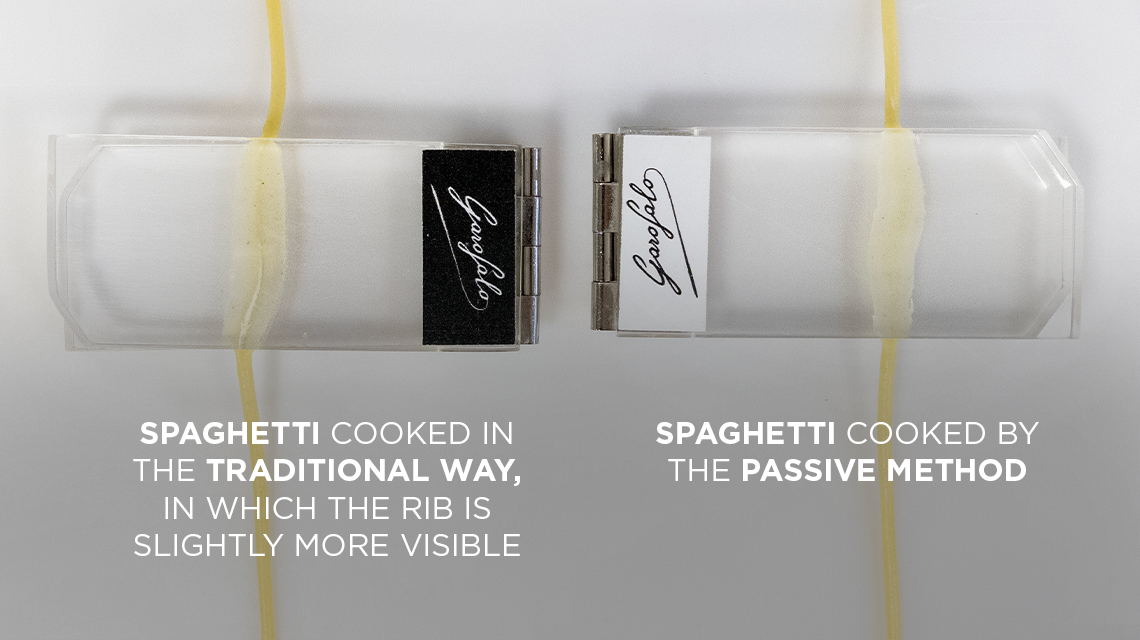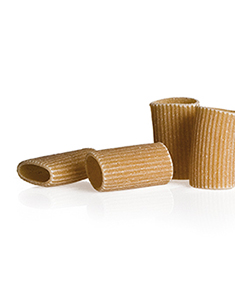
21-12-2022
The pros and cons of Passive Cooking explained by Pasta Garofalo
There’s been a lot of talk about passive cooking of pasta in the past few months.
And, as usual, we wanted to find out the truth about the matter. So we analysed the question from every point of view.
In Pastificio Lucio Garofalo’s laboratory, we experimented with the passive cooking technique on all our types of pasta (from short pasta such as Penne rigate to long pasta like Spaghetti and special pasta such as Gigantoni). We present our findings here.
FLAVOUR
We are experts on pasta, and have been for 300 years. Those who choose our pasta want a top-quality product, and this is why we feel it is our duty to report that passive cooking does not produce as good a flavour as the traditional method of cooking pasta.
The infographic below sums up the two cooking methods, traditional and passive, with instructions for both and the main pros and cons.

Not all pasta shapes produced the same results. Spaghetti respond best to cooking with the element turned off, while short pasta does not perform as well.
Top quality pasta such as ours stands out for its excellent texture, which is not the same following passive cooking.
This table shows the results of the tests we performed with Spaghetti and Penne Rigate.
Our assessment takes into consideration the 7 parameters identified by UnionFood: Cooking time specified on the package; Firmness after cooking; Separability; Presence of core; Sticky texture; Ability to absorb sauce; Taste.
Comparative table
Penne Rigate
Spaghetti
Penne Rigate | Metodo tradizionale | Metodo cottura passiva |
|---|---|---|
Time required to cook pasta completely | 11 minutes | 13 minutes |
Ease of separation: individual pieces of pasta don’t stick together due to the presence of starch on their surfaces | No pasta stuck together | No pasta stuck together |
Al dente: resistance of the pasta under the teeth | Excellent | Good, but anomalous, unevenly cooked, some pieces have not been adequately hydrated. |
Presence of core: presence of a slender raw core in the innermost part of the pasta (visible on the slide) | Correct, slightly raw | Correct, slightly raw |
Stickiness: presence of a sticky coating on the surface of the pasta after cooking | Correct | Correct |
Absorption of sauce: the pasta must thoroughly absorb the sauce and combine well with it | Correct | Correct |
Taste: an overall judgement of all the flavour and texture sensations perceived upon tasting the pasta. | Excellent, no problems identified | Good, slightly anomalous texture and flavour with a floury sensation |
Spaghetti | Metodo tradizionale | Metodo cottura passiva |
|---|---|---|
Time required to cook pasta completely | 10 minutes | 12 minutes |
Ease of separation: individual pieces of pasta don’t stick together due to the presence of starch on their surfaces | No pasta stuck together | No pasta stuck together |
Al dente: resistance of the pasta under the teeth | Excellent | Optimal |
Presence of core: presence of a slender raw core in the innermost part of the pasta (visible on the slide) | Correct, some slightly raw spots | Correct, some slightly raw spots |
Stickiness: presence of a sticky coating on the surface of the pasta after cooking | Correct | Correct |
Absorption of sauce: the pasta must thoroughly absorb the sauce and combine well with it | Correct | Correct |
Taste: an overall judgement of all the flavour and texture sensations perceived upon tasting the pasta. | Excellent, no problems identified | Excellent, no problems identified |
For more information on the tests conducted on spaghetti, download the pdf.
SAVINGS
How much money and energy can be saved by passive cooking?
First, we need to talk about putting the lid on the pot while cooking pasta. Putting the lid on saves 30% on water consumption and 10% on energy consumption, saving about 20 grams of CO2 emissions every time you cook pasta.
Supposing you cook pasta 300 times a year, you will save 15 euros and five and a half kilograms of CO2 emissions.
In calculating the savings resulting from passive cooking, we took into account the price of natural gas and electricity in the month of October.
If you cook pasta for a family of four three hundred times a year using the passive cooking method on an induction cooker, you can save up to 60 euros a year.
But if you use a gas cooker, you save only 7 euros.
Total energy savings in one year of passive cooking are equivalent to the amount of energy required to charge a mobile phone for 15 years.
But is passive cooking the only way to save energy and money?
No! We actually have a number of virtuous habits we can adopt for more sustainable cooking, in every way. As we have seen, putting the lid on the pot is an essential rule, but there is more we can do.
KEEP AN EYE ON THE WATER
Be careful about the amount of water you use: don’t boil too much water and you will save not only water but energy. The average proportion is 2 litres per 200 g pasta, but you can reduce this to 1.4 litres per 200 g, resulting in considerable savings.
DON’T WASTE TIME
Another aspect to keep in mind is the time between the water coming to a boil and actually putting the pasta in the pot. For example, if you forget and let the water boil for 5 minutes before you put the pasta in, every day for a whole year, you will waste enough energy to charge a smartphone for almost 7 years.
So keep an eye on that pot! In our study, we provide all the data necessary for an overall assessment of passive cooking compared to traditional cooking.
A word of advice for those of you who choose to serve Pasta Garofalo every day: try cooking pasta with this alternative method for yourself, but be aware that you won’t get the level of excellence you’re used to.
Every way of saving energy and protecting the environment is useful.
But there are so many other things we can do, and it’s important to make informed choices.








